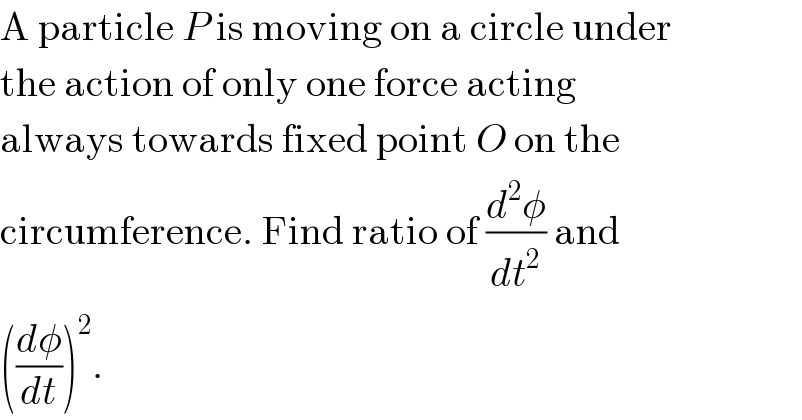
Question and Answers Forum
Question Number 22145 by Tinkutara last updated on 11/Oct/17

Commented by Tinkutara last updated on 11/Oct/17

Commented by sma3l2996 last updated on 12/Oct/17
![we have F^→ =ma^→ ⇔a^→ =−(F/m)u^→ ...(i) and OP^(→) =2Rcos(φ)u^→ so v^→ (P)=((dOP^(→) )/dt)=2R[−φ^. sin(φ)u^→ +φ^. cos(φ)k^→ ]=2Rφ^. (−sinφu^→ +cosφk^→ ) and a^→ (P)=(dv^→ /dt)=2R[φ^(..) (−sinφu^→ +cosφk^→ )+φ^. (−φ^. cosφu^→ −φ^. sinφk^→ −φ^. sinφk^→ −φ^. cosφu^→ )] so : a^→ =2R[(−φ^(..) sinφ−2φ^. ^2 cosφ)u^→ +(φ^(..) cosφ−2φ^. ^2 sinφ)k^→ ] ...(ii) we have (i)=(ii) so 2R(−φ^(..) sinφ−2φ^. ^2 cosφ)=((−F)/m) and φ^(..) cosφ−2φ^. ^2 sinφ=0 so φ^(..) cosφ=2φ^. ^2 sinφ ⇔φ^(..) =2φ^. ^2 tan(φ) ...(3i) φ^(..) sinφ+2φ^. ^2 cosφ=(F/(2Rm)) ...(4i) (3i)→(4i)⇒ 2φ^. ^2 tan(φ)sin(φ)+2φ^. ^2 cosφ=(F/(2Rm)) 2φ^. ^2 cosφ(((tan(φ)sinφ)/(cosφ))+1)=(F/(2Rm)) 2φ^. ^2 cosφ(tan^2 φ+1)=(F/(2Rm)) ((dφ/dt))^2 =φ^. ^2 =(F/(4Rm))cosφ and φ^(..) =2φ^. ^2 tanφ=2((F/(4Rm))cosφ)tanφ so : (d^2 φ/dt^2 )=φ^(..) =(F/(2Rm))sinφ](Q22149.png)
Commented by sma3l2996 last updated on 12/Oct/17

Answered by ajfour last updated on 12/Oct/17

Commented by Tinkutara last updated on 12/Oct/17

